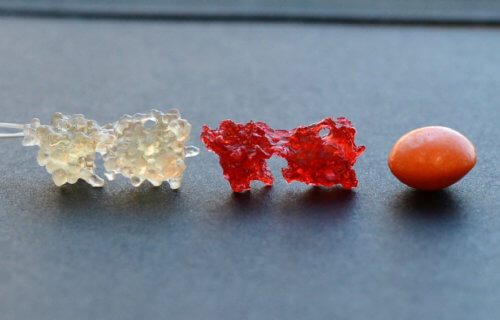WACO, Texas — There is a belief that when someone loses one of their senses, such as seeing or hearing, their other abilities become stronger. Now, a groundbreaking invention is giving blind individuals the ability to see again — using their mouths.
Scientists have created candy-like gummies which can enable blind science students to “see” shapes. The peanut-sized sweets help them access imagery better than handheld devices. Researchers from Baylor University used 3D-printing technology to mimic the dimensions of folded proteins. These strings of amino acids hold the key to good health.
In tests, 281 blindfolded students differentiated the shapes with more than 85 percent accuracy. More than four in ten performed better with the gummy on their tongues in comparison to a quarter of participants who did best using their hands.
Corresponding author Dr. Bryan Shaw developed the prototypes for his son. The 10-year-old cancer survivor was left with only partial vision after developing an eye tumor. Overall, more than 55,000 schoolchildren and college students in the U.S. are legally blind.
Creating an affordable and convenient treatment for blindness
They devices contain gelatin and are similar to the normal sugary confectioneries popular with kids. Scientists can also add any flavor and make ones as small as a grain of rice. They are also made out of non-toxic resin.
“They may offer a cheap, convenient way for students with blindness to access 3D scientific imagery,” Dr. Shaw says in a statement to SWNS. “Blind students often use handheld models to visualize complex objects such as molecular structures. However, it would not be practical for students to receive one of these models for every image in their textbooks, leaving plenty of scientific imagery out of reach for those with blindness.”
Despite the mouth having finer sensors, most studies have not explored it when it comes to tactile learning.
“Models were made as small as rice grain and could be coded with flavor and packaged like candy,” researchers write in the journal Science Advances.
In mouth, hand, and eyesight tests, using the gummies proved as effective as visual programs that involve colored blocks and animations on a screen.
“Students recognized structures by mouth at 85.59% accuracy, similar to recognition by eyesight using computer animation,” the Baylor team reports. “Recall accuracy of structures was higher by mouth than hand for 40.91% of students, equal for 31.82%, and lower for 27.27%.”
About 36 million people worldwide deal with blindness, including a million children. Another 216 million people live with serious visual impairments. For youngsters in school, they face particular challenges in science, technology, engineering, and math as well as potential bias from educators and peers. Blindness can erode the sense of belonging and make patients want to give up.
How do you make a gummy candy to treat vision loss?
The new gummies are the smallest molecular models ever fabricated by scientists. They come in two sizes, with a maximum of either 10 mm or 20 mm in diameter.
“Both easily fit into the mouth. Nonedible models were printed with an eyelet for the attachment of a safety loop (e.g., dental floss),” researchers explain in their report. “This lanyard can be held by the student to prevent swallowing or used to attach a label.”
The team adds these specialized devices are also easily storable, just like regular candy treats.
“As a demonstration, we filled a partitioned box of ‘Nerds’ candy with models coded in grape and orange,” the study authors continue.
To make the edible versions, scientists injected hot gelatin into a simple and inexpensive food silicone mold of each protein structure. Each edible or nonedible model accurately depicted the atomic structure of the protein, with micrometer-scale contours.
“Making science accessible to persons with blindness is a grand challenge. We must remember that resolving blindness is what science does best,” Dr. Shaw and the team concludes. “The business of science over the past century has been to help people visualize things they could never see with their eyes.”
SWNS writer Mark Waghorn contributed to this report.
